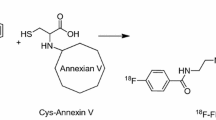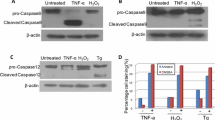Abstract
Utilization of molecular imaging of apoptosis for clinical monitoring of tumor response to anti-cancer treatments in vivo is highly desirable. To address this need, we now present ML-9 (butyl-2-methyl-malonic acid; MW = 173), a rationally designed small-molecule detector of apoptosis, based on a novel alkyl-malonate motif. In proof-of-concept studies, induction of apoptosis in tumor cells by various triggers both in vitro and in vivo was associated with marked uptake of 3H-ML-9 administered in vivo, in correlation with the apoptotic hallmarks of DNA fragmentation, caspase-3 activation and membrane phospholipid scrambling, and with correlative tumor regression. ML-9 uptake following chemotherapy was tumor-specific, with rapid clearance of the tracer from the blood and other non-target organs. Excess of non-labeled “cold” compound competitively blocked ML-9 tumor uptake, thus demonstrating the specificity of ML-9 binding. ML-9 may therefore serve as a platform for a novel class of small-molecule imaging agents for apoptosis, useful for assessment of tumor responsiveness to treatment.






Similar content being viewed by others
References
Bock NA, Zadeh G, Davidson LM, Qian B, Sled JG, Guha A, Henkelman RM (2003) High-resolution longitudinal screening with magnetic resonance imaging in a murine brain cancer model. Neoplasia 5:546–554
Fenton JJ, Weiss NS (2004) Screening computed tomography: will it result in overdiagnosis of renal carcinoma? Cancer 100:986–990
Zinreich SJ (2002) Imaging in laryngeal cancer: computed tomography, magnetic resonance imaging, positron emission tomography. Otolaryngol Clin North Am 35:971–991
Griffin N, Gore ME, Sohaib SA (2007) Imaging in metastatic renal cell carcinoma. AJR Am J Roentgenol 189:360–370
Padhani AR (2002) Functional MRI for anticancer therapy assessment. Eur J Cancer 38:2116–2127
Therasse P, Arbuck SG, Eisenhauer EA, Wanders J, Kaplan RS, Rubinstein L, Verweij J, Van Glabbeke M, van Oosterom AT, Christian MC, Gwyther SG (2000) New guidelines to evaluate the response to treatment in solid tumors. European Organization for Research and Treatment of Cancer, National Cancer Institute of the United States, National Cancer Institute of Canada. J Natl Cancer Inst 92:205–216
Gollob JA, Bonomi P (2006) Historic evidence and future directions in clinical trial therapy of solid tumors. Oncology (Williston Park) 20:10–18
Khamly KK, Hicks RJ, McArthur GA, Thomas DM (2008) The promise of PET in clinical management and as a sensitive test for drug cytotoxicity in sarcomas. Expert Rev Mol Diagn 8:105–119
Nihashi T, Hayasaka K, Itou T, Sobajima T, Kato R, Ito K, Ito Y, Ishigaki T, Naganawa S (2007) Usefulness of FDG PET for diagnosis and radiotherapy of the patient with malignant lymphoma involving bone marrow. Radiat Med 25:130–134
Ung YC, Maziak DE, Vanderveen JA, Smith CA, Gulenchyn K, Lacchetti C, Evans WK (2007) 18 Fluorodeoxyglucose positron emission tomography in the diagnosis and staging of lung cancer: a systematic review. J Natl Cancer Inst 99:1753–1767
Chong S, Lee KS (2007) Spectrum of findings and usefulness of integrated PET/CT in patients with known or suspected neuroendocrine tumors of the lung. Cancer Imaging 7:195–201
van Waarde A, Cobben DC, Suurmeijer AJ, Maas B, Vaalburg W, de Vries EF, Jager PL, Hoekstra HJ, Elsinga PH (2004) Selectivity of 18F-FLT and 18F-FDG for differentiating tumor from inflammation in a rodent model. J Nucl Med 45:695–700
Salskov A, Tammisetti VS, Grierson J, Vesselle H (2007) FLT: measuring tumor cell proliferation in vivo with positron emission tomography and 3′-deoxy-3′-[18F]fluorothymidine. Semin Nucl Med 37:429–439
Been LB, Suurmeijer AJ, Cobben DC, Jager PL, Hoekstra HJ, Elsinga PH (2004) [18F]FLT-PET in oncology: current status and opportunities. Eur J Nucl Med Mol Imaging 31:1659–1672
Meiler J, Schuler M (2006) Therapeutic targeting of apoptotic pathways in cancer. Curr Drug Targets 7:1361–1369
Hu W, Kavanagh JJ (2003) Anticancer therapy targeting the apoptotic pathway. Lancet Oncol 4:721–729
Fernandez-Luna JL (2007) Apoptosis regulators as targets for cancer therapy. Clin Transl Oncol 9:555–562
Thiagarajan P, Tait JF (1990) Binding of annexin V/placental anticoagulant protein I to platelets. Evidence for phosphatidylserine exposure in the procoagulant response of activated platelets. J Biol Chem 265:17420–17423
Zhao M, Beauregard DA, Loizou L, Davletov B, Brindle KM (2001) Non-invasive detection of apoptosis using magnetic resonance imaging and a targeted contrast agent. Nat Med 7:1241–1244
Vermeersch H, Loose D, Lahorte C, Mervillie K, Dierckx R, Steinmetz N, Vanderheyden JL, Cuvelier C, Slegers G, van de Wiele C (2004) 99mTc-HYNIC Annexin-V imaging of primary head and neck carcinoma. Nucl Med Commun 25:259–263
Faust A, Wagner S, Law MP, Hermann S, Schnockel U, Keul P, Schober O, Schafers M, Levkau B, Kopka K (2007) The nonpeptidyl caspase binding radioligand (S)-1-(4-(2-[18F]Fluoroethoxy)-benzyl)-5-[1-(2-methoxymethylpyrrolidinyl)s ulfonyl]isatin ([18F]CbR) as potential positron emission tomography-compatible apoptosis imaging agent. Q J Nucl Med Mol Imaging 51:67–73
Cohen A, Ziv I, Aloya T, Levin G, Kidron D, Grimberg H, Reshef A, Shirvan A (2007) Monitoring of chemotherapy-induced cell death in melanoma tumors by N, N′-didansyl-l-cystine. Technol Cancer Res Treat 6:221–234
Aloya R, Grimberg H, Reshef A, Levin G, Kidron D, Cohen A, Ziv I (2006) Molecular imaging of cell death in vivo by a novel small molecule probe. Apoptosis 11:2089–2101
Damianovich M, Ziv I, Heyman SN, Rosen S, Shina A, Kidron D, Aloya T, Grimberg H, Levin G, Reshef A, Bentolila A, Cohen A, Shirvan A (2005) ApoSense: a novel technology for functional molecular imaging of cell death in models of acute renal tubular necrosis. Eur J Nucl Med Mol Imaging 33:281–289
Reshef A, Shirvan A, Grimberg H, Levin G, Cohen A, Mayk A, Kidron D, Djaidetti R, Melamed E, Ziv I (2007) Novel molecular imaging of cell death in experimental cerebral stoke. Brain Res 1144:156–164
Reshef A, Shirvan A, Waterhouse RN, Grimberg H, Levin G, Cohen A, Ulysse LG, Friedman G, Antoni G, Ziv I (2008) Molecular imaging of neurovascular cell death in experimental cerebral stroke by PET. J Nucl Med 49:1520–1528
Reshef A, Shirvan A, Shohami E, Grimberg H, Levin G, Cohen A, Trembovler V, Ziv I (2008) Targeting cell death in vivo in experimental traumatic brain injury by a novel molecular probe. J Neurotrauma 25:569–580
Bevers EM, Comfurius P, Dekkers DW, Zwaal RF (1999) Lipid translocation across the plasma membrane of mammalian cells. Biochim Biophys Acta 1439:317–330
Sahu SK, Gummadi SN, Manoj N, Aradhyam GK (2007) Phospholipid scramblases: an overview. Arch Biochem Biophys 462:103–114
Nagata S, Golstein P (1995) The fas death factor. Science 267:1449–1456
Suttie JW (1980) Mechanism of action of vitamin K: synthesis of gamma-carboxyglutamic acid. CRC Crit Rev Biochem 8:191–223
Stirling Y (1995) Warfarin-induced changes in procoagulant and anticoagulant proteins. Blood Coagul Fibrinolysis 6:361–373
Waterhouse RN, Mardon K, O’Brien JC (1997) Synthesis and preliminary evaluation of [123I]1-(4-cyanobenzyl)-4-[[(trans-iodopropen-2-yl)oxy]methyl]piperidin e: a novel high affinity sigma receptor radioligand for SPECT. Nucl Med Biol 24:45–51
Waterhouse RN, Chang RC, Atuehene N, Collier TL (2007) In vitro and in vivo binding of neuroactive steroids to the sigma-1 receptor as measured with the positron emission tomography radioligand [18F]FPS. Synapse 61:540–546
Madras BK, Gracz LM, Fahey MA, Elmaleh D, Meltzer PC, Liang AY, Stopa EG, Babich J, Fischman AJ (1998) Altropane, a SPECT or PET imaging probe for dopamine neurons: III. Human dopamine transporter in postmortem normal and Parkinson’s diseased brain. Synapse 29:116–127
Vakifahmetoglu H, Olsson M, Zhivotovsky B (2008) Death through a tragedy: mitotic catastrophe. Cell Death Differ 15:1153–1162
Mansilla S, Bataller M, Portugal J (2006) Mitotic catastrophe as a consequence of chemotherapy. Anticancer Agents Med Chem 6:589–602
Amaravadi RK, Thompson CB (2007) The roles of therapy-induced autophagy and necrosis in cancer treatment. Clin Cancer Res 13:7271–7279
Fang K, Chiu CC, Li CH, Chang YT, Hwang HT (2007) Cisplatin-induced senescence and growth inhibition in human non-small cell lung cancer cells with ectopic transfer of p16INK4a. Oncol Res 16:479–488
Michalakis J, Georgatos SD, Romanos J, Koutala H, Georgoulias V, Tsiftsis D, Theodoropoulos PA (2005) Micromolar taxol, with or without hyperthermia, induces mitotic catastrophe and cell necrosis in HeLa cells. Cancer Chemother Pharmacol 56:615–622
Brown JM, Attardi LD (2005) The role of apoptosis in cancer development and treatment response. Nat Rev Cancer 5:231–237
Kim R, Emi M, Tanabe K (2006) The role of apoptosis in cancer cell survival and therapeutic outcome. Cancer Biol Ther 5:1429–1442
Leist M, Jaattela M (2001) Four deaths and a funeral: from caspases to alternative mechanisms. Nat Rev Mol Cell Biol 2:589–598
Acknowledgments
ML-9 is an investigational imaging product developed by Aposende Ltd (formerly NST Ltd.), and all authors receive personal compensation from Aposense.
Author information
Authors and Affiliations
Corresponding author
Additional information
H. Grimberg, G. Levin and A. Shirvan contributed equally to this article.
Rights and permissions
About this article
Cite this article
Grimberg, H., Levin, G., Shirvan, A. et al. Monitoring of tumor response to chemotherapy in vivo by a novel small-molecule detector of apoptosis. Apoptosis 14, 257–267 (2009). https://doi.org/10.1007/s10495-008-0293-7
Published:
Issue Date:
DOI: https://doi.org/10.1007/s10495-008-0293-7




